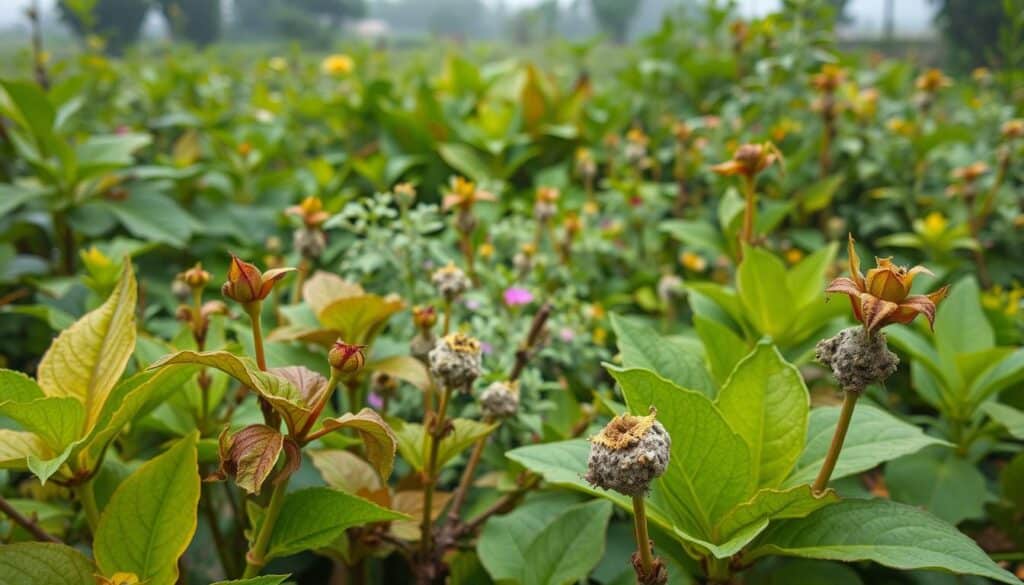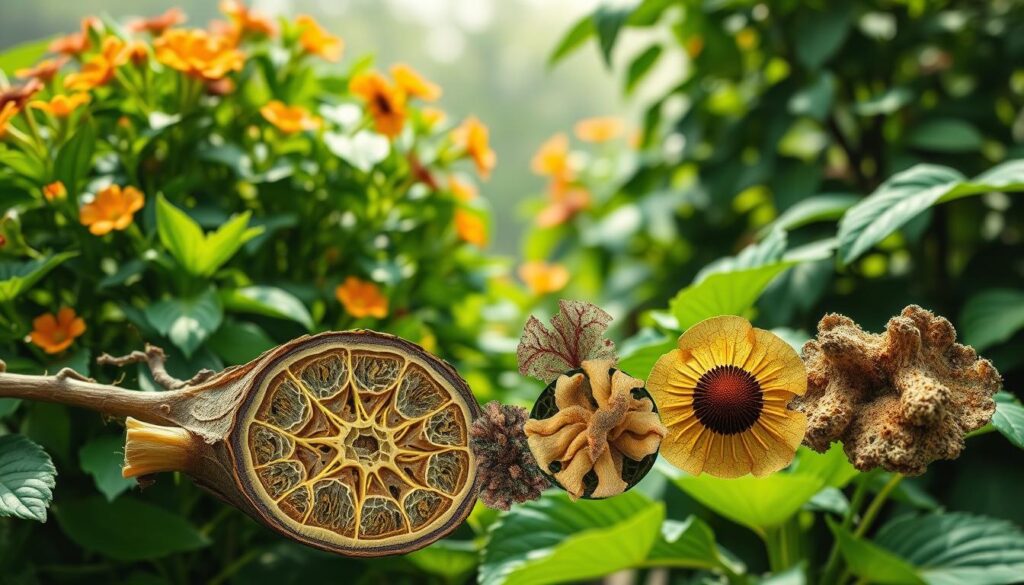Understanding Plant Diseases: Causes & Prevention

About the Game
Plant diseases are a big deal for farmers and home gardeners. They can really hurt crop yield and quality. Knowing how to stop and manage these diseases is key for healthy plants.
We’ll look into why plant diseases happen, what signs to watch for, and how to deal with them. Understanding the science of plant diseases helps in protecting your plants. This is what we aim to share here.
Introduction to Plant Diseases
Plant illnesses come about when something disrupts a plant’s normal functions. This leads to poor growth and other issues, creating big problems in farming and nature. Learning about these illnesses, called plant pathology, is vital for agriculture and keeping plants safe.
Anúncios
Knowing about plant diseases helps farmers and experts save their crops. Recognizing signs of sickness early is key to prevent serious damage. This knowledge supports healthy plants and eco-friendly farming.

Anúncios
What Causes Plant Diseases?
Plant diseases come from two main types: the ones that spread and the ones that don’t. The spreadable ones are caused by bad bugs like fungi, bacteria, viruses, and tiny worms called nematodes. These tiny culprits grow inside plants and can move to others, causing a lot of harm. The non-spreadable diseases happen because the environment around the plant isn’t right. This could be not enough nutrients, too much pollution, or weather that’s too wet or dry.
Let’s talk about fungi first. They are complex little creatures that grow by sending out spores. They can break down plant parts and make them sick. Bacteria are tiny single-cell organisms that cause big problems, like making plants wilt or get blotchy. Then there are viruses, which need living cells to grow. They hitch a ride inside a plant, making it look stunted or changing its color.
Nematodes are another troublemaker for plants. These tiny worms live in the soil and attack plant roots, making the plants look weak and discolored. When nematodes infest a garden, they can hurt plant roots for a long time. This makes the plants even more likely to get sick from other diseases.
Common Symptoms of Plant Diseases
Knowing how to spot plant diseases is key to handling them well. Look out for wilting, dead patches, leaf spots, blights, and abnormal growths. These signs mean the plant might be sick. Spotting them early helps stop more damage.
Wilting can happen if the plant doesn’t get enough water or has root issues. Dead areas, called necrosis, show as blotchy or widespread damage. Spots on leaves could mean a fungus or bacteria is present. Galls and blights show the plant is fighting off disease.
Sometimes, you might see fungal parts like mycelium or spores on the plant. This means the plant is definitely sick. Seeing these helps figure out exactly what’s wrong.
It’s important to understand two terms: necrosis and hyperplasia. Necrosis means parts of the plant are dead, showing up as blotches. Hyperplasia means the plant is growing too much, causing galls or curled leaves. Both are ways plants react to sickness or stress, showing why watching plants closely is crucial.
Types of Fungal Plant Diseases
Fungi are key players in plant health, causing different kinds of diseases. These diseases can badly damage crops and change landscapes. Signs include plants wilting, parts rotting, and growth that looks odd.
Some well-known fungal diseases include:
- Late blight of potato caused by Phytophthora infestans
- Dutch elm disease caused by Ceratocystis ulmi
- Powdery mildew affecting a range of plants, like roses and cucumbers
- Root rot diseases that hit annuals and perennials hard
It’s important to know about these diseases to control them better. Each disease has its own lifecycle and spreading ways. Knowing the symptoms and how these fungi work helps protect plants.
Specific Examples of Plant Diseases
Learning about specific plant diseases shows their effects and how to manage them. Dutch elm disease, caused by the fungus Ceratocystis ulmi, poses a big risk to elm trees in the U.S. It leads to wilting, leaves falling off, and the death of trees. The disease came to the U.S. through imported wood, showing why it’s vital to check plant materials to stop its spread.
Ash dieback disease is another critical illness, caused by the fungus Hymenoscyphus fraxineus. It hits ash trees hard, causing leaves to fall, the tree to thin out from the top, and overall decline. This disease has big knock-on effects for nature and businesses that rely on forests.
There are also other plant diseases that need a mention. Black stem rust in wheat and coffee rust are two big ones that hurt farming a lot. It’s important to understand these diseases and fight them to keep both food crops and garden plants healthy. These examples show the tough battle in keeping plants healthy.
The Role of Environmental Factors in Plant Diseases
Environmental factors greatly affect a plant’s health. They can either help plants grow or make them sick. Things like not having enough nutrients, too little water, and pollution are big problems that hurt plants.
Plants under stress from bad environments are more likely to get sick. For example, not enough water weakens their roots. This makes it hard for them to get the food they need, hurting their growth and making them more likely to catch diseases.
Pollutants in the soil and air also weaken plants. These toxins can harm plant tissues, allowing diseases to enter more easily. So, knowing how these problems affect plants is key for keeping them healthy.
How Do Pathogens Spread Plant Diseases?
It’s crucial to know how diseases spread to manage plant health well. Pathogens, like disease-causing organisms, have several ways to move around. Let’s look at the main ways they do this:
- Spores: Fungal spores travel through wind or water. This lets them infect plants far away.
- Vectors: Insects, animals, and even people help pathogens move. For example, aphids carry viruses when they feed on different plants.
- Infected Material: Contaminated seeds, tools, or soil from sick plants can spread bacteria and viruses. This starts disease outbreaks in healthy areas.
Knowing about these ways of spreading can really help stop disease outbreaks. It keeps plants healthy, especially in farms.
Preventing Plant Diseases
Stopping plant diseases is key to good farming. Changing crops regularly helps improve soil and stop disease. This stops bugs and diseases, making crops healthier and more plentiful.
Choosing disease-resistant plants is a smart move. These plants get less sick, which means better harvests and less chemicals. This way, farming can stay productive and sustainable for a long time.
Control Measures for Plant Diseases
To keep crops healthy and productive, controlling plant diseases is key. Chemical and biological fungicides are crucial in this battle, targeting harmful pathogens. By applying these fungicides, we can greatly reduce pathogen growth and stop diseases from spreading.
Farmers aiming to improve their disease management might choose Integrated Pest Management (IPM) strategies. IPM is a comprehensive method that combines different control actions for sustainable disease fighting. It uses a mix of fungicides, cultural tactics, and biological approaches to protect plants from pathogens.
- Regular monitoring for symptoms of disease to catch issues early.
- Applying fungicides at strategic times to maximize their efficacy.
- Implementing crop rotation to disrupt disease cycles.
- Utilizing resistant crop varieties to minimize reliance on chemical treatments.
The Importance of Early Detection
Spotting plant diseases early is key to keeping crops healthy. If you catch diseases when they first appear, you can act fast. This helps avoid major losses across your farm. It’s important to watch your crops closely and regularly.
Having a plan to check on your plants often is smart. When you look at your plants up close, you can see if something’s wrong. Knowing what’s wrong early means you can fix it right away.
Advanced tools make spotting diseases easier and faster. These technologies help point out the exact cause, so you can treat your crops correctly. Farmers who stay on top of disease detection keep their crops in good shape.
Future of Plant Disease Management
Plant disease management is evolving through new technology and research. Using genetic engineering, scientists are creating plants that resist diseases better. This approach helps protect our crops and promotes sustainable farming.
Precision agriculture is another exciting development. It uses data and smart technology to check on plant health. By doing this, farmers can treat plants early and use fewer chemicals.
Research is key in finding new ways to fight plant diseases. Scientists study how plants and pathogens interact. Their discoveries help farmers use better disease management practices. This makes crops stronger and helps farming adapt to new challenges.
Conclusion
Knowing about plant disease causes, symptoms, and how to stop them is key for healthy plants. Both farmers and gardeners fight a tough battle against these diseases. It’s crucial to know how to spot diseases quickly to save crops.
Using smart methods to manage diseases not only increases how much we harvest but also prepares us to fight off disease. As we learn more about farming, it’s important to keep learning for anyone working with plants.
In the end, putting in the effort to understand and use this knowledge will lead to better environments and more crops. This shows why it’s important to always stay alert and informed about plant health.
FAQ
What are the main causes of plant diseases?
How can I identify plant diseases?
What are the differences between infectious and noninfectious diseases?
How do fungi affect plants?
What role do nematodes play in plant health?
Why is early detection of plant diseases important?
What preventive measures can be taken against plant diseases?
How can plant diseases be controlled effectively?
What is the significance of abiotic factors in plant diseases?
What advancements are being made in plant disease management?
Game Details
No
No